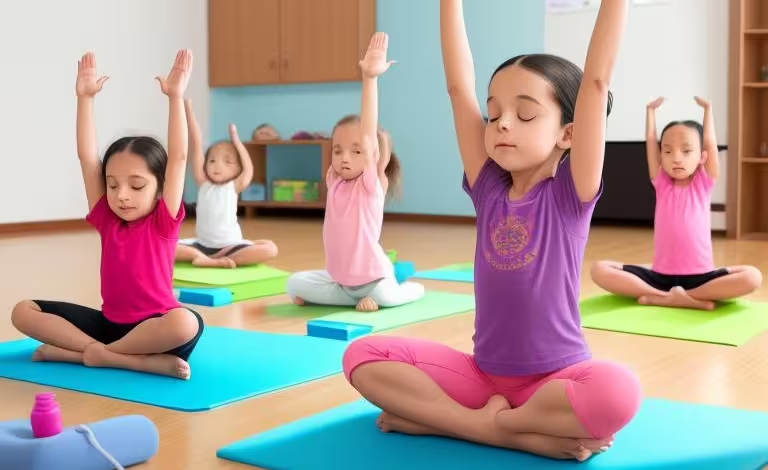
7 Incredible Benefits of Yoga for Kids You Need to Know!
Yoga is not just for adults; it's fantastic for kids too! From calming their minds to improving their physical health, yoga can be a game-changer for children. In this article, we'll explore the amazing benefits of yoga for kids and how you can get them started. So, let's dive into the world of yoga and discover how it can positively impact your child's life.
What is Yoga for Kids?
Yoga for kids is a fun and engaging way to help children develop flexibility, strength, and mindfulness. It involves various poses, breathing exercises, and relaxation techniques tailored to suit a child's age and abilities. Unlike adult yoga, yoga for kids often incorporates playful elements, stories, and games to keep them interested and motivated.
1. Boosts Physical Health
Enhances Flexibility and Strength
One of the most obvious benefits of yoga for kids is that it helps improve their physical health. By practicing different yoga poses, children can enhance their flexibility, strength, and balance. This is crucial for their overall growth and development.
Improves Posture and Balance
Good posture and balance are essential for kids, especially as they grow and develop. Yoga helps in aligning their spine correctly and improving their balance, which can prevent common issues like slouching or poor posture.
2. Reduces Stress and Anxiety
Promotes Relaxation
Kids, just like adults, can experience stress and anxiety. Yoga introduces them to relaxation techniques that help calm their minds and reduce anxiety. Practices like deep breathing and meditation are great tools for managing stress.
Improves Sleep Quality
A relaxed mind leads to better sleep. Incorporating yoga into your child's routine can help improve their sleep quality, making them more refreshed and ready to take on the day.
3. Enhances Concentration and Focus
Boosts Cognitive Function
Yoga requires focus and concentration, which can help improve a child's cognitive functions. By practicing yoga regularly, kids can enhance their attention span and memory.
Encourages Mindfulness
Mindfulness is all about being present in the moment, and yoga is a great way to teach kids this valuable skill. Mindful practices can help children stay focused and attentive in their daily activities, including schoolwork.
4. Builds Self-Esteem and Confidence
Encourages Self-Acceptance
Yoga teaches kids to accept themselves and their abilities. It encourages a non-competitive environment where children can focus on their progress rather than comparing themselves to others.
Promotes Positive Body Image
Through yoga, kids learn to appreciate their bodies and what they can do. This promotes a healthy and positive body image, which is crucial during their formative years.
5. Fosters Creativity and Imagination
Engages the Mind
Yoga for kids often involves storytelling and imaginative play. This engages their minds and fosters creativity, making the practice more enjoyable and beneficial.
Encourages Expressive Movement
Yoga allows children to express themselves through movement. This expressive aspect of yoga can be a great outlet for kids to channel their emotions and creativity.
6. Improves Social Skills
Encourages Teamwork
Group yoga sessions encourage kids to work together and support each other. This can improve their social skills and help them develop a sense of community.
Builds Empathy
By practicing yoga with others, children learn empathy and understanding. They become more aware of their peers' feelings and develop better interpersonal skills.
7. Promotes a Healthy Lifestyle
Encourages Physical Activity
Yoga is a fun way to keep kids physically active. It helps instill a love for movement and exercise, which can lead to a healthier lifestyle as they grow.
Teaches Healthy Habits
Through yoga, children learn about the importance of taking care of their bodies and minds. This holistic approach promotes overall well-being and encourages kids to adopt healthy habits early on.
Getting Started with Yoga for Kids
Find a Kid-Friendly Yoga Class
Look for local yoga studios or community centers that offer yoga classes specifically designed for kids. These classes are often tailored to be fun and engaging, making it easier for kids to enjoy the practice.
Practice at Home
You can also practice yoga with your child at home. There are plenty of online resources, videos, and books that provide easy-to-follow yoga routines for kids. Make it a fun family activity!
Use Props and Visuals
Kids love using props and visuals during yoga. Consider using colorful mats, yoga blocks, or even storytelling cards to make the practice more interactive and enjoyable.
Common Yoga Poses for Kids
Tree Pose (Vrksasana)
This pose helps improve balance and focus. Have your child stand on one leg and place the sole of the other foot on their inner thigh or calf, then raise their arms overhead like branches of a tree.
Cat-Cow Pose (Marjaryasana-Bitilasana)
Great for spine flexibility, this pose involves moving between a cat position (arching the back) and a cow position (sinking the back) while on all fours.
Butterfly Pose (Baddha Konasana)
This pose helps open the hips and encourages relaxation. Have your child sit with their feet together, knees bent, and gently flap their legs like butterfly wings.
Downward-Facing Dog (Adho Mukha Svanasana)
A classic pose that stretches the entire body, Downward-Facing Dog is great for building strength and flexibility. Encourage your child to form an inverted V-shape with their body, hands, and feet on the ground.
Tips for Practicing Yoga with Kids
Keep it Fun and Playful
Yoga should be fun for kids! Incorporate games, songs, and stories into the practice to keep them engaged and excited.
Be Patient and Encouraging
Children may take time to get used to yoga. Be patient and offer plenty of encouragement to keep them motivated.
Create a Safe and Comfortable Environment
Ensure the practice space is safe and comfortable. Use soft mats and ensure there is enough room for your child to move freely.
The Role of Parents in Yoga Practice
Lead by Example
Kids often mimic their parents. By practicing yoga yourself, you can inspire your child to join in and enjoy the benefits of yoga.
Encourage Regular Practice
Encourage your child to practice yoga regularly. It doesn't have to be a long session; even a few minutes each day can make a big difference.
Celebrate Their Progress
Celebrate your child's progress, no matter how small. Positive reinforcement can boost their confidence and make them more enthusiastic about yoga.
Yoga Games and Activities for Kids
Yoga Freeze Dance
Play some music and let your child dance around. When the music stops, they have to freeze in a yoga pose. This game is fun and helps them learn different poses.
Animal Yoga
Assign different yoga poses to various animals and have your child mimic them. For example, they can do the Cat Pose for a cat or the Downward-Facing Dog for a dog.
Yoga Storytelling
Create a story that incorporates different yoga poses. As you narrate the story, have your child perform the poses. This makes the practice imaginative and engaging.
Benefits of Yoga for Different Age Groups
Preschoolers (3-5 years)
For preschoolers, yoga helps develop motor skills, coordination, and body awareness. It also introduces them to mindfulness and relaxation techniques in a playful manner.
School-Age Kids (6-12 years)
At this age, yoga can improve concentration, self-esteem, and social skills. It also provides a healthy way to manage stress and anxiety, especially during school years.
Teenagers (13-18 years)
For teenagers, yoga can be a great way to cope with the physical and emotional changes they experience. It helps build strength, flexibility, and mental clarity, promoting overall well-being.
Incorporating Yoga into the School Curriculum
Benefits for Students
Integrating yoga into the school curriculum can have numerous benefits for students. It can improve their focus, behavior, and academic performance while promoting physical health.
Benefits for Teachers
Teachers can also benefit from incorporating yoga into their routines. It can help them manage stress, improve their own well-being, and create a positive classroom environment.
Practical Implementation
Schools can implement yoga programs by training teachers, inviting yoga instructors, or using online resources. Even a few minutes of yoga each day can make a significant difference in the school environment.
Yoga for kids is a wonderful practice that offers numerous physical, mental, and emotional benefits. By incorporating yoga into your child's routine, you can help them develop healthy habits, manage stress, and improve their overall well-being. Whether through classes, home practice, or fun activities, yoga can be a positive and enriching experience for children of all ages. So, roll out that yoga mat and start exploring the amazing world of yoga with your kids today!




